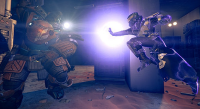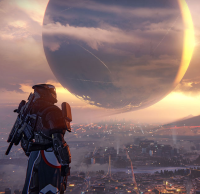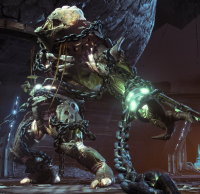Destiny
 It’s weird to consider that when I first played Halo and became a faithful Bungie fan, I would have been viewed a bit as a poser. I wasn’t really familiar with Marathon nor did I play Myth, so my knowledge of the company came specifically from my interest in their new sci-fi franchise. I followed the weekly updates all the way to Halo 2, even.
It’s weird to consider that when I first played Halo and became a faithful Bungie fan, I would have been viewed a bit as a poser. I wasn’t really familiar with Marathon nor did I play Myth, so my knowledge of the company came specifically from my interest in their new sci-fi franchise. I followed the weekly updates all the way to Halo 2, even.
The funny thing is, you can learn a lot about Bungie’s philosophy by following the evolution of that franchise. They believe in accessibility, but put their real efforts into the challenge. If you want to play Halo: Combat Evolved “as it was meant to be played”, then you load up Legendary and experience the oppressive force of the Covenant army. From Halo 3 onward, Bungie encouraged exploration and exploitation through a variety of hidden Easter Eggs and skulls, the latter of which required the player to progress through the game on already harder difficulties. Combat arenas, a variety of weapon types, and a growing pile of enemy modifications that test each player’s resourcefulness.
Destiny is built from the ground up with this philosophy in mind, though it requires the player to reach the “endgame” content to really understand how. When you first begin there’s always a hard mode available, but the rewards for it are limited and the only real adjustment is in the number of enemies that you face. Otherwise there’s nothing too challenging about Destiny, nothing that exceeds Halo’s Heroic difficulty, at least.
The cost is that Destiny also lacks any sort of Easy mode. When you select the lowest difficulty in any of the Halo games, the A.I. may as well be playing for you. The Grunts panic easily, the weapon fire does little damage, and it is possible to survive without having a solid handle on how to aim properly. No doubt this ease of access for inexperienced players is one of the reasons Halo: Combat Evolved had become so popular amongst mainstream audiences. Even young or less skilled players had a difficulty that was suited for them.
Destiny completely lacks this lower rung of challenge, chopping the ladder so that you must be this tall to climb to the top. If you can’t reach the base of the ladder and haul yourself up to meet the challenge, then you are simply left behind.
This is why the endgame of Destiny, after completing the story missions and reaching level twenty, comes off as such a grind. I suddenly understand what some MMO players have meant when they declare “the game doesn’t start until you level-cap”, because the story missions aren’t the real Destiny. The story missions are the grind to become worthy. Once you hit level twenty, once you unlock rare and legendary armor, are able to participate in the daily and weekly missions, that’s when the journey really begins.
A journey that requires a lot of time spent wandering the same environments you’ve wandered over and over again, sniping and slaughtering anything that lies in your path, repeating errands for the vague characters up at the Tower and snagging the occasional shiny object required for upgrades.
It’s all about the combat, all about keeping you in the action, but in order to even stand a chance at survival in the game’s primary missions, you have to grind away doing repetitive tasks.
Bungie was at least a clever enough developer to understand that the combat had to be excellent, and the lessons learned from their previous franchise really shines out here. The A.I. is smarter than before, ducking for cover as soon as they spot a sniper rifle, flanking and swarming players or, most surprisingly, rushing forward to divide and conquer. As the game gets harder and enemies reach higher levels, they become smarter and more deadly. Each enemy faction has a similar hierarchy of foes, but the lowest or highest class of these factions behaves very differently than the next. Not only does each race feel unique through appearance and animation, but their behaviors give them all a distinct identity. It changes the way a player will approach each foe, and as such changes how the player approaches missions on each planet.
 The player must also remain resourceful, though not in the same manner as the Halo games. None of the player weapons are drastically different from your usual shooter design, leaving the more imaginative weaponry in the hands of the alien menace. Instead, each class (and its subclass) will have a variety of differing abilities that will help the player in different ways, as well as special types of damage dealt by certain weapons. Instead of throwing a plasma grenade at an Elite to bypass its shield, you’ll equip a heavy machine gun with arc damage to wipe away blue-shaded shields of Fallen Captains instead.
The player must also remain resourceful, though not in the same manner as the Halo games. None of the player weapons are drastically different from your usual shooter design, leaving the more imaginative weaponry in the hands of the alien menace. Instead, each class (and its subclass) will have a variety of differing abilities that will help the player in different ways, as well as special types of damage dealt by certain weapons. Instead of throwing a plasma grenade at an Elite to bypass its shield, you’ll equip a heavy machine gun with arc damage to wipe away blue-shaded shields of Fallen Captains instead.
It’s a much more rock-paper-scissors design traditional of role-playing games, though it is more about matching colors. Different colors of shields have different levels of resistance, and you’re always going to want spare weaponry for different types of foes. It requires the player to think beyond merely lining up headshots.
This is the reason to play Destiny. This is the draw. Drop in, shoot enemies, and get out. It just takes some time until the player is forced to learn how to play properly.
The endgame content is primarily built around ideas introduced in Halo 3 and finalized in Halo: Reach. Provide the players with daily and weekly objectives to complement their multiplayer experiences, be it competitive or cooperative play. Once you reach level twenty, you’ll be able to access the “Daily Story Missions”, where you repeat a mission from the “campaign” at a higher difficulty. You’ll also have access to “Weekly Strikes”, a single, longer mission requiring three players team up, boosted to a higher difficulty setting.
Finally comes the Raid, where you and up to five other players try to complete an incredibly difficult and challenging mission. It’s the real final dungeon of the game, putting a player’s skills to the absolute limit.
There’s one new recipe to this entire mixture that Bungie has not really dealt with before, and that is the aspect of leveling and loot. The roleplaying mechanics that help govern damage dealt, damage taken, and rate of advancement. In order to surpass level twenty, the player not only requires the luck of the draw when obtaining new gear as a reward, but on being able to find a wide array of ingredients for purchasing and upgrading their equipment. This is where the real grind comes in, and this is why a lot of players have expressed frustration with Bungie.
It’s also where I’m trying to get a handle on Bungie’s philosophy beyond Halo. What, exactly, is their goal with Destiny? Why does it require so much time and dedication to rank up your character? Further, if a player manages to put in a lot of time, why are certain required items (such as vanguard marks) limited in how many you earn a week? My best guess is to prevent it from impacting the player versus player arenas of The Crucible.
Bungie clearly wants players to be challenged. They want the enemy A.I. to be intelligent and ruthless, and they want players to be resourceful and clever despite overwhelming odds. Destiny is using the MMORPG structure to funnel players into a Legendary difficulty rather than leaving it as an optional mode to experience the game. The Vault of Glass, the weekly strikes, all of these modifiers and high level requirements are Destiny as Bungie wants it to be played.
 It makes sense in its own right. These missions explain a universe where the Traveler has fled to its final corner, to make its last desperate stand with the help of humanity (and assorted robots and space elves), fighting back against the dark forces that would oppress it.
It makes sense in its own right. These missions explain a universe where the Traveler has fled to its final corner, to make its last desperate stand with the help of humanity (and assorted robots and space elves), fighting back against the dark forces that would oppress it.
Is the long grind worth it, however? The greatest effect it has is to prevent players from trading in the game too soon, forcing them to keep playing it for a while so that they might hold on long enough that they’ll just stick around and wait for the DLC to drop.
I’ve been playing Destiny for about a month now on Playstation 3, mostly intermittently with my roommate and a friend of mine about twice a week. Yet I never really understood how Destiny operated until this past week, when I began to leap from planet to planet seeking out public events, loot chests, upgrade materials, and patrols to run. It feels like busywork, but at least it’s a form of busywork where I get to smile in satisfaction as I blow another Vandal’s head off from halfway across the map.
Destiny is most certainly Bungie’s greatest work to date (mechanically, at least), but I cannot help but wonder if this was the best route to their overall goal. If a long trek through errands and near-worthless rewards in order to funnel players into the real fight was the best move. Players, after all, do not like it when it is obvious they are following someone else’s direction.
Perhaps every Bungie Weekly Update should include a healthy dose of “Would you kindly?”


